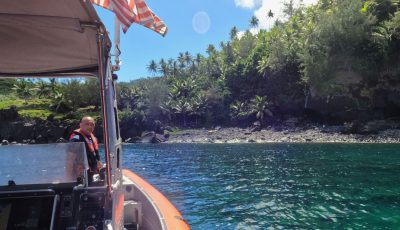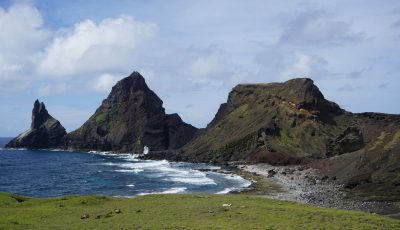No to the wholesale militarization of Pagan
Editor’s Note: Due to its length, the following article is being published in two parts. The first part was published yesterday.
Last of a two-part series
Socioeconomics and Environmental Justice
The Draft EIS assumes that “[b]ecause the island is currently undeveloped and unpopulated, there would be no impacts related to population change, public services, or community character and cohesion” (Draft EIS at 4-454). The Navy uses that same rationale to avoid environmental justice concerns (id.). As discussed above, the Navy’s assumptions about current conditions on Pagan are not accurate. For that reason alone, the Draft EIS must be thoroughly revised and recirculated.
The Draft EIS also fails to take a hard look at economic opportunities that would be destroyed by the Project. For example:
* The Draft EIS claims “small-scale ecotourism that would be expected to occur without the proposed action could likely occur with the proposed action” (Draft EIS Appendix Q at 5-5) and, for that reason, the project “is not anticipated to have an effect on” ecotourism (Draft EIS at 4-454). The claim is ridiculous. Pagan’s
ecotourism potential is entirely based on the island’s unspoiled environmental conditions. It is difficult to imagine anything that will spoil those conditions faster than massive live-fire military training activities. There is no “small scale ecotourism” market for war zones.
* Pagan’s most significant mineral resources is pozzolan, which exists in large quantities on the island and is of extremely high quality. Pagan’s pozzolan resources have been the subject of a number of different studies dating back to the 1970s. The studies have come to somewhat different conclusions, but all of them recognize the significant value of the resource and the fact that there is a nearby market for the product in China (Draft EIS Appendix Q at 4-11to4-12). Over the years, several entities have invested substantial time and effort in studying and securing permits to gather pozzolan on Pagan. One of the appendices to the Draft EIS questions whether such efforts will be successful under current market conditions, but it fails to address (i) the possibility of changes to those market conditions (even while admitting that prices are “volatile”) and (ii) impacts associated with the loss of permitting and royalty revenues to government agencies.
Finally, it is important to emphasize the Navy’s failure to address Environmental Justice concerns. Executive Order 12898 requires every EIS to address the potential for “disproportionately high and adverse human health or environmental effects” on “minority populations” in “the United States and its territories and possessions.” The term “minority populations” includes “Pacific Islanders” such as the people of the Northern Islands. In fact, the people of the Northern Islands are a minority twice over—a minority within the population of the CNMI, which itself is a minority population within the United States. It is beyond dispute that impacts to Pagan will disproportionately affect those who consider the island a physical and spiritual homeland. These are precisely the impacts that Executive Order 12898 requires the Navy to address.
Cultural Resources
The Draft EIS fails to address the significant cultural impacts of the Project on Pagan, its residents, the people of the Northern Islands, or the CNMI as a whole:
* The Navy has never undertaken a thorough cultural resources survey of Pagan. Fewer than 600 acres (of a total of 11,680) of the island have been surveyed in detail. This absence of information is particularly problematic in the context of the combined training proposed for Pagan, which (unlike the unit training proposed for Tinian) is not restricted to established paths or areas (Draft EIS at 2-121).
* Although only a small portion of Pagan has been surveyed, the results confirm the presence of a significant number of historic and cultural resources: More than 180 historic sites, of which at least 110 are deemed eligible for the National Register of Historic Places. This is not an appropriate location for live-fire training.
* Contractors working for the Navy have prepared a Traditional Cultural Property study, a redacted version of which accurately identifies six National Register-eligible TCPs on Pagan. But the study fails to identify a number of other TCPs, including those associated with traditional gathering, agricultural activities, and latte sites.
* The Draft EIS admits that a significant number of latte sites would be disturbed or destroyed by the project. The Navy appears to believe this is not a significant issue because latte sites lack continuing cultural importance. The Navy is mistaken. Latte are important cultural resources linking us to the past and they should be (and are) respected as such. The destruction of a latte site is a significant impact that must be avoided.
* I understand that the preparers of the TCP study originally agreed to evaluate the entire island of Pagan as a TCP, but the evaluation was subsequently abandoned. The redacted version of the TCP study provides no justification for the Navy’s failure to evaluate the entire island as a TCP. On the contrary, evidence from the study suggests that such an evaluation would be warranted (see, e.g., TCP Study at 3-12 (“The entire island of Pagan is medicine. It’s very unique.”)). Indeed, Pagan serves an important cultural function that extends beyond the significance of any individual location on the island. It is a spiritual homeland, a place whose purity helps us connect with our cultural identity. The proposed militarization of Pagan would cut to the core of our culture, and would make it impossible for future generations to experience the cultural significance of the island in the same way we do.
Conclusion
The Navy has proposed a project that will literally destroy the island of Pagan, our physical and spiritual homeland, and it has attempted to justify that proposal on the flimsiest of bases: A grossly inadequate Draft EIS that many members of the public have been prevented from reviewing.
I urge you to reconsider this path. There are other, less-damaging ways to ensure that the nation’s military personnel get the training they need.
Jerome Kaipat Aldan is mayor of the Northern Islands, Third Senatorial District.



























